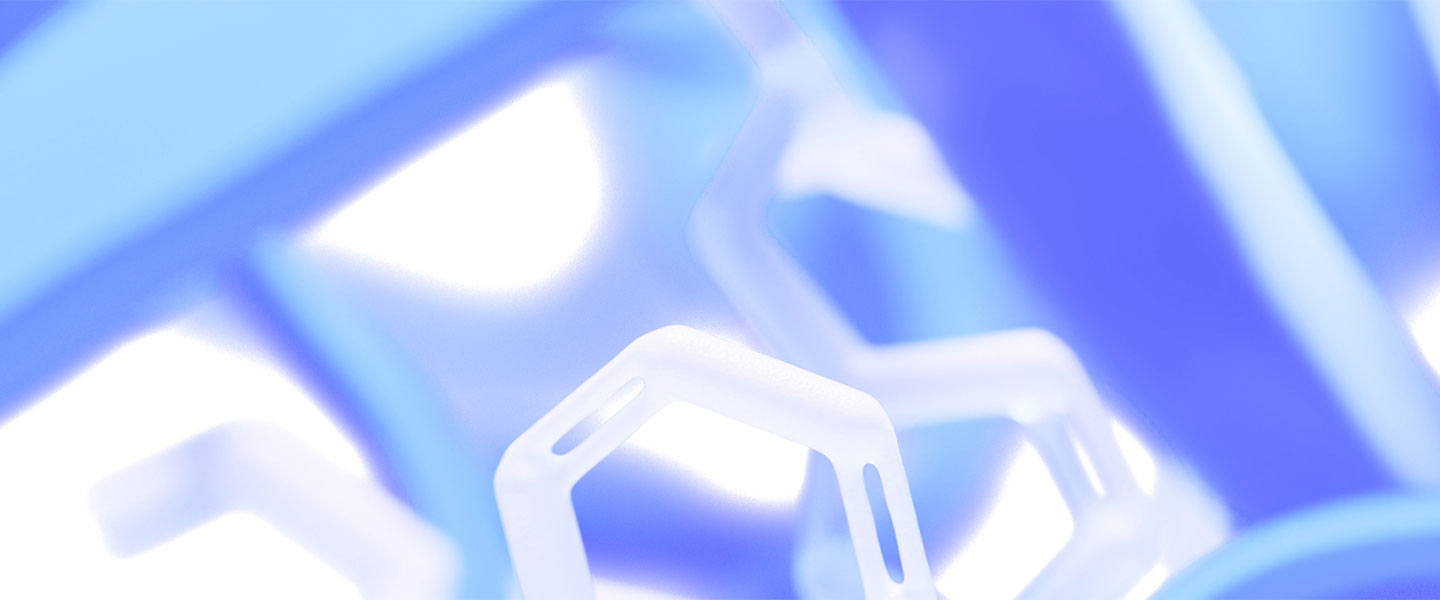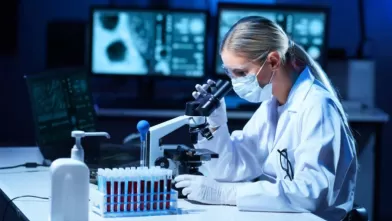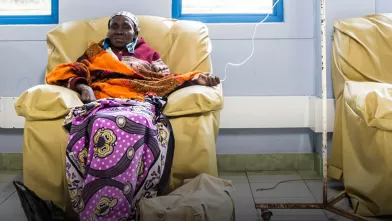- Home
- Science
- Diseases & Conditions
- Breast Cancer
What Is Breast Cancer?
Breast cancer is a disease that arises when cells in one or both breasts grow uncontrollably.1 As these cells divide more rapidly than they should, they can accumulate into a tumor.2
Breast cancer can begin in any of the three main parts of the breast1:
- The lobules (glands that produce milk)
- The ducts (tubes that transport milk to the nipple)
- The connective tissue that surrounds them
According to the World Health Organization, about 85% of breast cancers start in the cells lining the ducts and 15% begin in the cells lining the lobules.3 At stage 0, the beginning of breast cancer, the disease is usually symptomless and contained within the lobule or duct. Breast cancer may then invade nearby breast tissue, lymph nodes, and then other organs. This spreading, or metastasis, can make breast cancer fatal.3
When breast cancer is diagnosed early, treatment options like surgery, radiation, chemotherapy, and hormonal therapy can help reduce the risk of death.3
Prevalence of Breast Cancer
Breast cancer is the second most common cancer among people assigned female at birth in the United States. Each year, it’s responsible for nearly 30% of all cancers among this demographic.4
The American Cancer Society estimates that there are about 287,850 new cases of invasive breast cancer and around 51,400 cases of ductal carcinoma in situ (DCIS) annually among those assigned female at birth. The disease tends to be more prevalent among people who are middle-aged and older. The median age of diagnosis is 62.4
Tragically, breast cancer is a leading cause of cancer death among people assigned female at birth, killing approximately 43,250 each year.4
Overall, the incidence of breast cancers has grown by .5% per year in recent years. However, the death rate has declined: 43% through 2020. Experts attribute this change to early detection, awareness campaigns, and treatment improvements. Now, there are more than 3.8 million breast cancer survivors in the United States.4
Causes and Risk Factors
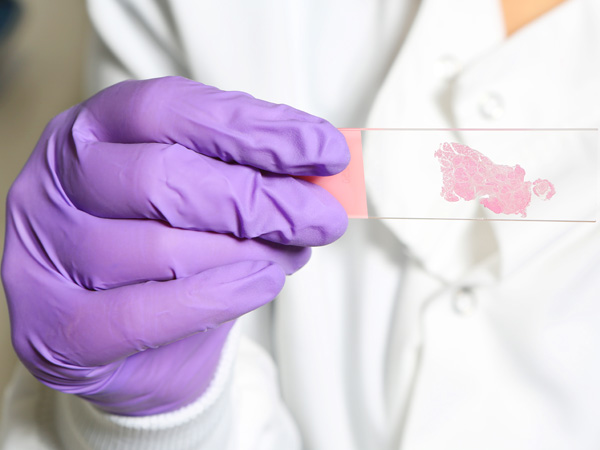
What Causes Breast Cancer?
Scientists still do not fully understand the causes of breast cancer. Research has shown that certain risk factors increase the likelihood of developing breast cancer. And while gene mutations can cause healthy breast cells to become cancerous, many of those gene changes have not yet been pinpointed by researchers.5
Breast Cancer and Genetics
Genes influence how cells work.5 The proto-oncogenes contained by normal cells regulate cell growth, and genes called tumor-suppressor genes, which determine how often cells divide. If proto-oncogenes or tumor suppressor genes mutate, cells can become cancerous.5
Some genetic mutations are inherited in the DNA that parents pass on to their children at birth, including gene changes that are known to increase the risk of developing cancer.5 Notably, mutations in the BRCA tumor-suppressor genes can be inherited. Yet only around 10% of breast cancer diagnoses are linked to known inherited gene abnormalities. Other cases may develop from still unknown hereditary mutations. About 90% of breast cancers are thought to arise from unidentified acquired gene changes that happen after birth, stemming from factors like radiation, exposure to cancer-causing chemicals, or random cellular changes.5
Breast Cancer Risk Factors
Certain hormonal, environmental, and lifestyle factors may increase the risk for breast cancer, including6:
- Aging
Most people with breast cancer are diagnosed after age 50.
- Menstrual cycle history
An extended exposure to hormones from starting menstrual periods before the age of 12 or beginning menopause after 55 can increase breast cancer risk.
- Reproductive history
People who experience their first pregnancy after age 30, do not breastfeed, or never complete a full-term pregnancy may face greater risk.
- Dense breasts
Dense breasts have more connective tissue than fatty tissue, which increases the risk of breast cancer and makes it harder to spot potentially cancerous changes on a mammogram.
- Personal and family history
A person is at greater risk if an immediate relative (parent, sibling, or child) or multiple relatives on either side of the family have had breast cancer or ovarian cancer.
- Previous radiation therapy
Experiencing radiation to the chest or breasts (for example, to treat another cancer) before age 30 raises the risk of developing breast cancer.
- Diethylstilbestrol (DES) usage
Patients who took DES, a drug given during pregnancy between 1940 and 1971 to prevent miscarriage, or people whose mothers took it while pregnant with them have a higher breast cancer risk.
- Inactive lifestyle and obesity
Being physically inactive throughout life and/or overweight after menopause can increase risk.
- Hormones
Taking a hormone replacement therapy that includes both estrogen and progesterone for more than five years during menopause can increase the risk of breast cancer. Studies have also found links between breast cancer and certain birth control pills, as well as hormonal changes caused by working a night shift.
- Drinking alcohol and smoking
Increased alcohol consumption raises the risk of breast cancer. Smoking has also been linked to a higher risk.
Male Breast Cancer
Breast cancer in people assigned male at birth can also occur, but it’s much less common than it is for those assigned female at birth.3 Before puberty, all children have some breast tissue, including a few ducts under their nipples.7 At puberty, estrogen causes ducts to grow and lobules to form.7,8 When levels of these hormones are low, the breast tissue typically doesn't grow much. And while people assigned male at birth still have breast ducts, they have few, if any, lobules.7
How Common Is Male Breast Cancer?
Roughly 1% of all breast cancers occur in people assigned male at birth.3 In 2022, experts expect the U.S. to see 2,710 new diagnoses of invasive breast cancer and 530 deaths from the disease in this demographic.9
Male Breast Cancer Causes and Risk Factors
Researchers don't fully understand what causes male breast cancer, but several known risk factors include:10
- Aging
Aging increases the risk of developing male breast cancer, with an average age of 72 at diagnosis.
- Family history
About 20% of patients with male breast cancer have a close family member with the disease. Inherited gene mutations, such as mutations in the BRCA gene, also increase the risk.
- Klinefelter syndrome
Roughly 1 in 1,000 people assigned male at birth have cells with one or more extra X chromosomes. Instead of the more common XY pair, their cells may have an XXY combination. Klinefelter syndrome, as the condition is known, often causes infertility, higher levels of estrogen, and a 20- to 60-times greater chance of developing male breast cancer.
- Radiation therapy
Having one's chest repeatedly exposed to radiation increases the risk of developing breast cancer.
- Alcohol and liver disease
Heavy drinking increases the risk of liver disease. Because the liver regulates sex hormones, severe liver diseases like cirrhosis can lead to higher levels of estrogen and thus increase male breast cancer risk.
- Estrogen therapy
Because estrogen is associated with breast cancer, there is a slightly higher risk for patients who were treated for prostate cancer with estrogen-related drugs.
- Obesity
Fat cells convert androgens into estrogens which can increase breast cancer risk.
- Testicular conditions
Having undescended testicles, having mumps as an adult, or having testicles surgically removed increases the risk of developing breast cancer.
Male breast cancer treatment is similar to other breast cancer treatments, but researchers are currently exploring whether different therapies would elicit a better response.11
Breast Cancer Prevention
Exercising regularly, maintaining a healthy weight, moderating alcohol consumption, and breastfeeding your children, if possible, are some ways to reduce the risk of breast cancer.12
Having risk factors does not mean that breast cancer will develop. Some people with several risk factors never develop breast cancer, while others with no known risk factors get the disease. Discussing one’s individual health with a healthcare provider can help with understanding personal risks.6
Breast Cancer Types
Most breast cancers begin in the cells lining the milk ducts or lobules.13 There are other types of cancer that can be found in the breast, but they are rare. This includes:
- Sarcomas, which can begin in the connective breast tissue cells.14 Sarcomas account for less than 1% of breast cancers.13
- Angiosarcomas, which begin in cells that line blood vessels or lymph vessels and can involve breast tissue or skin.13
- Paget’s disease of the breast, which starts in the breast ducts and spreads to the skin of the nipple (accounting for 1% to 3% of breast cancers).13
- Phyllodes tumor of the breast, which is usually a benign growth in the connective tissue of the breast. It can sometimes be cancerous. Phyllodes tumors of the breast are rare.13
- Breast Cancer Hormone Receptors and HER2 Status
To identify an appropriate treatment option, oncologists may test cancer cells to determine whether they have certain kinds of proteins that are receptors for the hormones estrogen and progesterone. Receptors are places where substances carried by the blood, such as hormones, can attach. Healthy breast cells have receptors where the hormones estrogen and progesterone can connect.15
Breast cancer cells can also have these receptors. In fact, about 75% of breast cancers have receptors. Knowing whether these receptors are present is important because the receptors influence how cancer cells grow. And knowing how cancer cells are growing helps doctors select appropriate treatment options.15
Based on the presence or absence of these receptors, breast cancer, breast cancer can be classified as hormone-receptor positive (HR+) or hormone-receptor negative (HR-). Tests will tell oncologists about HR status. Cancer that is HR+ has receptors for estrogen, progesterone, or both hormones. Cancer that is HR- does not have receptors for estrogen and progesterone.15
For patients with HR+breast cancer, blocking estrogen and progesterone from reaching receptors can slow down cancer growth and stop it from spreading. Oncologists will often treat HR+ cancers with hormone therapy, which are drugs that reduce hormone levels, or even work to block the receptors. This is not currently a treatment option for patients with HR- disease.15
- HER2-positive (HER2+)
HER2 is a protein that can help breast cancer develop more quickly. If breast cancer cells have levels of HER2 that are above a certain level, they are classified as HER2-positive (HER2+). If levels are lower than a certain level, the breast cancer is classified as HER2-negative (HER2-).16
Cancers that have higher amounts of the HER2 protein occur in about 15% to 20% of breast cancer cases. These cancers have a better chance of responding to HER2-targeted drugs. Just as with knowing ER and PR status (whether a tumor has estrogen [ER] or progesterone [PR] receptors)17, knowing HER2 status helps oncologists select the best breast cancer treatment options.16
- Triple-negative breast cancer
This type of breast cancer is HER2-negative, ER-negative (meaning low or no level of HR2), and PR-negative (meaning they lack progesterone receptors). This means the cancer has lower or no levels of HER2 protein. Since these cancer cells do not have hormone receptors, hormone therapy is not an option. And since these cancer cells do not have elevated levels of HER2, drugs addressing HER2 are also not appropriate. Chemotherapy may be an option.15,16
- “In Situ” vs Invasive Breast Cancer
Breast cancer is called "in situ" when it’s contained within the area where it began.18 Ductal carcinoma in situ is confined in the breast ducts,18 and lobular carcinoma in situ is contained in the lobules.19
Breast cancer is described as "invasive" when it spreads into the surrounding breast tissue.20 The most common types are invasive ductal carcinoma, which accounts for around 80% of invasive breast cancers, and invasive lobular carcinoma, which accounts for about 10% of invasive breast cancer cases.20
Breast Cancer Stages
In addition to identifying the type of breast cancer a patient has, doctors will classify the cancer's stage. This helps to determine treatment and the prognosis for survival.21,22
Breast cancers are classified from stage 0 through stage 4, based on these characteristics:21,22
- The size of the tumor
- Whether or not lymph nodes have cancer cells in them and how many lymph nodes are involved.
- Whether it has involved the tissue of the chest wall outside of the breast
- Whether the cancer has spread to organs distant from the breast (metastasized)
- ER, PR, and HER2 status
- Grade of differentiation of the cancer cells, based on how much they look like normal cells
Metastatic Breast Cancer
In 2017, researchers projected that more than 150,000 people with XX chromosomes in the U.S. would have metastatic breast cancer.23 Otherwise known as stage 4 breast cancer, metastatic cancer is cancer that has reached other parts of the body, such as the liver,brain lungs or bones.24
Metastatic disease can arise as “distant recurrence” months or years after initial diagnosis at an earlier stage.23
Initial diagnoses of metastatic breast cancer are called de novo metastatic breast cancer. This designation indicates that the cancer has already reached other parts of the body by the time it is first detected.25
Metastatic breast cancer is incurable. But some treatments may prolong life, alleviate symptoms, reduce tumor size, or slow tumor growth. Patients will often continue a specific treatment if it controls the cancer and if side effects are manageable. If the treatment stops working or the patient can no longer tolerate specific treatments, patients may try other treatment options.24
Breast Cancer Symptoms
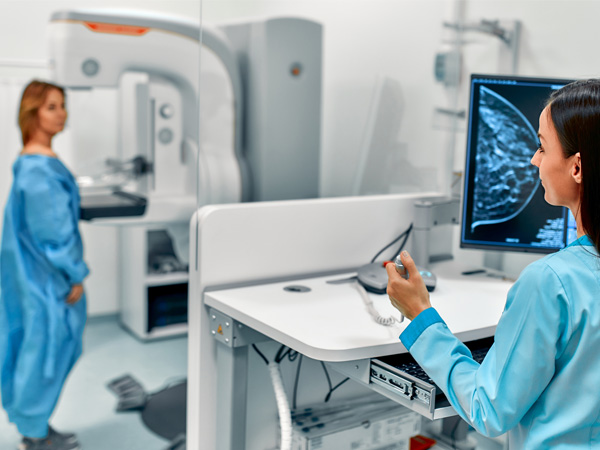
While experts highlight the benefits of regular breast cancer screening, they also caution that mammograms don't always find every instance of breast cancer.26 It's important to know how your breasts normally look and feel so you can spot early signs of breast cancer.26
A new lump or mass is the most common presentation that a person can detect. Although cancerous masses are typically painless and hard with irregular edges, they can also be tender (or even painful) with soft or rounded edges. Thus, any new lump should be checked by an experienced health care provider.26
Other breast cancer symptoms might include:26
- Swelling or any change in the size or shape of the breast
- Swollen or tender lymph nodes under the arm or around the collar bone
- Skin dimpling on the breast (possibly resembling an orange peel)
- Pain or tenderness in the breast or nipple
- Nipple retraction (inverting inward)
- Red, dry, flaky, or thickened skin on the nipple or breast skin
- Nipple discharge other than breast milk
Many of these symptoms can be caused by other conditions, but they should be reported to healthcare professionals for evaluation.26
Diagnosis and Treatment
Breast Cancer Treatment
After diagnosing patients with breast cancer, doctors will explain options and work with patients to create treatment plans specific to their types of cancer and goals of treatment.21,22 Some breast cancer treatment can be highly effective, with a survival rate of 90% or higher if the disease is discovered early.3
Treatment options typically differ depending on whether breast cancer is detected early, or whether it has reached metastatic stage.21,23,24
- Early-Stage Breast Cancer Treatment
Patients with early-stage breast cancer tend to follow a similar journey through cancer care. That care journey typically begins with neoadjuvant treatment, which is treatment that’s administered before surgery. After surgery, patients may receive therapies, referred to as adjuvant treatment, such as radiation, chemotherapy, endocrine therapy, and targeted therapies. It’s helpful to understand each of these therapies in greater detail.
- Neoadjuvant Treatment
Treating early-stage breast cancer sometimes involves neoadjuvant therapy. Neoadjuvant therapies are therapies that a patient receives prior to surgery. Typically, these therapies are systemic therapies, which are treatments that reach cells throughout the body by traveling through the bloodstream. Neoadjuvant systemic therapies may include chemotherapy or endocrine therapy.27,28 Radiation therapy may also be administered as neoadjuvant treatment.29
Oncologists will administer neoadjuvant treatment to shrink tumor size. It can also help inform treatment decisions that the oncologist makes later. 27
- Surgery
There are several surgical options for ductal carcinoma in situ (DCIS), or breast cancer that can be surgically removed. Depending on their type of breast cancer, patients may have procedural options. Those options may include:30
- Lumpectomy: The lumpectomy and other breast-sparing surgeries involve removing cancerous tissue, and some normal surrounding tissue, leaving the rest of the breast intact. Surgeons may remove some lymph nodes for additional study, and/or part of the chest wall if the cancer is close to it. You may also hear lumpectomy referred to as breast-conserving surgery, partial mastectomy, quadrantectomy, or segmental mastectomy.
- Mastectomy: Mastectomy involves surgically removing all of the breast. There are different kinds of mastectomies that involve different amounts of tissue and lymph nodes.
- Mastectomy with reconstruction: This procedure combines a mastectomy with surgical reconstruction of the breast. Typically, a plastic surgeon will do this procedure using implants or tissue taken from other parts of the body to reconstruct what was removed.
- Radiation
Radiation therapy may follow breast cancer surgery. This treatment option uses high-energy rays or particles that target and eliminate breast cancer cells. There are two primary types of radiation for breast cancer treatment, which radiation oncologists use depending on the type of breast cancer and the type of breast cancer surgery:31
- External beam radiation therapy (EBRT): EBRT is the most frequently used radiation therapy for breast cancer. With EBRT, a machine focuses and delivers the radiation to the site of breast cancer. If the cancer reached other areas, such as lymph nodes or the chest wall, radiation oncologists may target these places as well.
- Brachytherapy: Whereas EBRT is an outside-in approach to radiation therapy, brachytherapy is an inside-out approach. Radioactive seeds or pellets are placed into breast tissue at the site of the removed tumor. These pellets or seeds are removed at the conclusion of therapy.
- Chemotherapy
Chemotherapy (chemo) also may be used after surgery. Chemotherapy delivered after surgery may be called adjuvant chemotherapy. This type of chemo is intended to eliminate any cancer cells that may linger after the surgery. This is important because these cancer cells are microscopic and may not show up on imaging tests. If these cells survive, they could lead to cancer in other parts of the body. Chemo may include the following drugs and drug types:32
- Anthracyclines
- Taxanes
- 5-fluorouracil
- Capecitabine
- Cyclophosphamide
- Carboplatin
- Endocrine therapy
People with breast cancer that involves hormones, namely estrogen or progesterone, may be candidates for endocrine therapy. This population includes people with breast cancers who are ER-positive (ER+) or PR-positive (PR+). Endocrine therapy may also be referred to as hormone therapy.33
Oncologists will often deliver hormone therapy after surgery, making it another type of adjuvant therapy. The idea is to use the hormones to prevent breast cancer from returning. Typically, patients will take endocrine therapy for about 5 years, but they may take it longer if their cancer has a higher chance of recurrence.33
- Targeted therapy
Targeted therapies are named for their ability to target breast cancer cell proteins that are responsible for how the cells grow and spread. These therapies use these proteins to work to stop or slow the growth of cancer cells. They may be administered via injection, as an IV, or as pills. There are targeted therapies for HER2-positive breast cancer, hormone receptor-positive breast cancer, for breast cancer featuring the BRCA gene mutation, and for triple-negative breast cancer.34
- Targeted therapy for HER2-positive breast cancer
- Monoclonal antibodies: Monoclonal antibodies are often used in cases of HER2-positive breast cancer, which comprise about 15% to 20% of all instances of breast cancer. Monoclonal antibodies are a type of man-made immune system proteins, which are called antibodies. They bind with the HER2 protein on cancer cells, which can slow or stop their growth.
- Antibody-drug conjugates: Antibody-drug conjugates are combination drugs that feature a monoclonal antibody and a chemotherapy drug. The monoclonal antibody attaches to the HER2 protein on the cancer cell, bringing the chemotherapy right to the site of the cancer.
- Kinase inhibitors: Kinases, such as HER2, are proteins that play a critical role in relaying growth messages to cells. Kinase inhibitors work to block the protein to stop cell growth messaging from happening.
- Targeted therapy for hormone receptor-positive breast cancer
These drugs work in conjunction with endocrine or hormone therapy:34
- CDK4/6 inhibitors: These drugs, which also inhibit a type of kinase, block specific proteins in hormone-receptor positive breast cancer cells. Blocking these proteins limits the cells’ ability to divide and may slow the growth of cancer.
- mTOR inhibitor: This type of targeted therapy blocks a specific protein, called mTOR, in hormone receptor-positive breast cancer. This can limit the cancer cells’ ability to grow or divide, and it may even stop tumors from creating new blood vessels, thwarting their growth.
- PI3K inhibitor: This targeted therapy blocks a type of the PI3K protein. Once this protein is blocked, it may stop the cancer cell from growing.
- Targeted therapy for BRCA gene mutations
BRCA1 and BRCA2 are two genes that are often responsible for breast cancer that is inherited, also known as hereditary breast cancer. When these genes are normal, they help create proteins that repair DNA when it becomes damaged. But when these genes are mutated, they can lead to cells that grow abnormally, which can in turn lead to breast cancer.35
Targeted therapy can help people with BRCA gene mutations who develop breast cancer. This type of targeted therapy involves a class of drugs known as PARP inhibitors. Under normal circumstances, PARP is a type of protein that helps cells repair damaged DNA within the cell. This work is similar to the BRCA gene function.34
Mutated BRCA genes struggle to repair damaged DNA. By adding a PARP inhibitor, the DNA repair process may stop completely in the cancer cells, causing them to die and slowing or stopping the spread of breast cancer.34
- Targeted therapy for triple-negative breast cancer
In cases of triple-negative breast cancer, the cancer cells lack estrogen or progesterone receptors and do not produce the HER2 protein, or produce very little of it. People with this type of breast cancer may receive an antibody-drug conjugate as a form of targeted therapy. An antibody-drug conjugate is a monoclonal antibody that is combined with a chemotherapy drug. In one example, the monoclonal antibody targets and binds with the Trop-2 protein on the breast cancer cells. Some cancer cells may have high levels of Trop-2, which can lead to accelerated cancer growth. Antibody-drug conjugates also deliver chemo at these sites.34
- Immunotherapy for breast cancer
In immunotherapy, drugs are used to prompt the patient’s immune system to identify and eliminate cancer cells. These drugs target specific proteins in the immune system that in turn boost the system’s ability to fight cancer.36
One common type of immune therapy drug is the PD-1 inhibitor. You may hear this drug referred to as a checkpoint inhibitor. That’s because the immune system features proteins called checkpoints, which stop the immune system from destroying healthy cells. Breast cancer cells are sometimes able to use these checkpoint proteins to their advantage, escaping elimination by the immune system. Checkpoint inhibitors, like the PD-1 inhibitor, override the PD-1 checkpoint, generating an immune response that can reduce the size of tumors.36
- Metastatic Breast Cancer Treatment
The patient journey for metastatic breast cancer differs from early-stage breast cancer because, at this point, cancer has spread beyond the breast tissue, possibly reaching the lymph nodes, bones, liver, lungs, brain, or other organs. Since metastatic breast cancer is incurable, the care objectives are to shrink or slow the growth of tumors, manage symptoms, and extend life.24
Like early-stage breast cancer, patients will typically progress through hormone therapy, chemotherapy, and targeted therapy. Metastatic breast cancer treatment may also include immunotherapy.24
Global Impact of Breast Cancer

At the close of 2020, an estimated 7.8 million people remained alive following a breast-cancer diagnosis within the past 5 years, according to the World Health Organization.3 In 2020, 2.3 million people worldwide were diagnosed with breast cancer, and 685,000 lost their lives to the disease.3
Innovations in breast cancer research have contributed to a five-year survival rate for cancer that is detected early to more than 90% in high-income countries. But the rate dips in other countries. In India and South Africa, the survival rates are 66% and 40%, respectively.3
Not only is the disease a burden on breast cancer patients and their families, but there's also a high global economic cost for cancer in general—including healthcare spending and productivity losses.37
Frequently Asked Questions About Breast Cancer
If you or someone you love has been diagnosed with breast cancer, you want answers fast.
- What are the best methods regarding how to check for breast cancer?
Being familiar with the normal look and feel of your breasts is a component of breast health.26 Also, mammograms to screen for cancer can support early detection.38
- What does a breast cancer lump feel like?
Breast cancer lumps are typically painless and hard with irregular edges. However, some patients may experience tender or even painful lumps with soft or rounded edges. That's why it's important to have any new lump checked by an experienced healthcare provider.26
- How does breast cancer start?
Breast cancer starts when cells in one or both breasts grow uncontrollably. As these cells divide more rapidly than they should, they accumulate into a mass. Tumors can grow in the breast's lobules (milk-producing glands), ducts (canals that transport milk to the nipple), or the connective tissue that surrounds it all.1,3
- Can men get breast cancer?
Yes, male breast cancer accounts for approximately 1% of all breast cancers.3 People assigned male at birth still have some breast tissue, breast ducts, and potentially some breast lobules. Those ducts and lobules are susceptible to breast cancer.7
- What types of breast cancer are there?
Most cancers of the breast are carcinomas (cancers that originate in cells lining the breast) that start in the milk ducts or lobules.13 Breast carcinomas start out in situ, meaning they are contained in the duct or lobule, but, without treatment, they can become invasive carcinomas that spread into the surrounding breast tissue and then to lymph nodes and other parts of the body.13,20
A less common type of breast cancer, angiosarcomas begin in cells that line blood vessels or lymph vessels and can involve breast tissue or skin. Overall, sarcomas including angiosarcoma account for less than 1% of all breast cancers. Phyllodes tumors begin in the connective tissue of the breast and are often benign but can become cancerous.13
- How quickly does breast cancer grow?
According to a study published in 2021, it takes about 180 days for a breast cancer tumor to double in size. This average has remained stable for about 80 years.39 Ploidy, a measure of the amount of DNA that cancer cells contain, is another factor that can determine how quickly breast cancer grows. Cancer cells with a normal amount of DNA, called diploid cells, typically spread and grow more slowly. Cancer cells with abnormal amounts of DNA, called aneuploid cells, typically spread and grow more quickly. While ploidy tests may offer insights into a person’s breast cancer diagnosis, they rarely alter the course of breast cancer treatment.40
Find a Pfizer clinical trial for breast cancer at PfizerClinicalTrials.com.
Explore breast cancer clinical trials at ClinicalTrials.gov.
Area of Focus: Oncology
Breast Cancer is a focus of Pfizer’s Oncology Therapeutic Area. Visit the Oncology Page.
- References
- What Is Breast Cancer? Centers for Disease Control and Prevention. https://www.cdc.gov/cancer/breast/basic_info/what-is-breast-cancer.htm. Last revised September 22, 2021. Accessed September 1, 2022.
- Tumor. National Cancer Institute. https://www.cancer.gov/publications/dictionaries/cancer-terms/def/tumor. Accessed Oct. 31, 2022.
- Breast cancer. World Health Organization. https://www.who.int/news-room/fact-sheets/detail/breast-cancer. Published March 26, 2021. Accessed September 1, 2021.
- Key Statistics for Breast Cancer. American Cancer Society. https://www.cancer.org/cancer/breast-cancer/about/how-common-is-breast-cancer.html. Last revised January 12, 2022. Accessed September 1, 2022.
- What Causes Breast Cancer? American Cancer Society. https://www.cancer.org/cancer/breast-cancer/about/how-does-breast-cancer-form.html. Last revised November 19, 2021. Accessed September 1, 2022.
- What Are the Risk Factors for Breast Cancer? Centers for Disease Control and Prevention. https://www.cdc.gov/cancer/breast/basic_info/risk_factors.htm. Last revised September 20, 2021. Accessed September 1, 2022.
- What Is Breast Cancer in Men? American Cancer Society. https://www.cancer.org/cancer/breast-cancer-in-men/about/what-is-breast-cancer-in-men.html. Last revised April 27, 2018. Accessed September 1, 2022.
- Javed A, Lteif A. Development of the human breast. Seminars in Plastic Surgery. 2013;27(01):005-012.
- Key Statistics for Breast Cancer in Men. American Cancer Society. https://www.cancer.org/cancer/breast-cancer-in-men/about/key-statistics.html. Last revised January 12, 2022. Accessed September 1, 2022.
- Risk Factors for Breast Cancer in Men. American Cancer Society. https://www.cancer.org/cancer/breast-cancer-in-men/causes-risks-prevention/risk-factors.html. Last revised April 27, 2018. Accessed September 1, 2022.
- Men With Breast Cancer Need More Treatment Options and Access to Genetic Counseling. U.S. Food and Drug Administration. https://www.fda.gov/consumers/consumer-updates/men-breast-cancer-need-more-treatment-options-and-access-genetic-counseling. Last revised June 15, 2021. Accessed September 1, 2022.
- What Can I Do to Reduce My Risk of Breast Cancer? Centers for Disease Control and Prevention. https://www.cdc.gov/cancer/breast/basic_info/prevention.htm. Last revised September 20, 2021. Accessed September 1, 2022.
- Types of Breast Cancer. American Cancer Society. https://www.cancer.org/cancer/breast-cancer/about/types-of-breast-cancer.html. Last revised November 19, 2021. Accessed September 1, 2022.
- Matsumoto RAEK, Hsieh SJK, Chala LF, Mello GGN de, Barros N de. Sarcomas of the breast: Findings on mammography, ultrasound, and magnetic resonance imaging. Radiol Bras. 2018;51(6):401-406.
- Breast Cancer Hormone Receptor Status. American Cancer Society. https://www.cancer.org/cancer/breast-cancer/understanding-a-breast-cancer-diagnosis/breast-cancer-hormone-receptor-status.html. Last revised November 8, 2021. Accessed September 1, 2022.
- Breast Cancer HER2 Status. American Cancer Society. https://www.cancer.org/cancer/breast-cancer/understanding-a-breast-cancer-diagnosis/breast-cancer-her2-status.html. Last revised August 25, 2022. Accessed September 1, 2022.
- Estrogen receptor, progesterone receptor tests. MedlinePlus. https://medlineplus.gov/lab-tests/estrogen-receptor-progesterone-receptor-tests/. Last revised September 21, 2021. Accessed January 18, 2023.
- Breast carcinoma in situ. https://www.cancer.gov/publications/dictionaries/cancer-terms/def/breast-carcinoma-in-situ. National Cancer Institute. Accessed January 23, 2023.
- Lobular carcinoma in situ (LCIS). American Cancer Society. https://www.cancer.org/cancer/breast-cancer/non-cancerous-breast-conditions/lobular-carcinoma-in-situ.html. Last revised. January 25, 2022. Accessed January 23, 2023.
- Invasive Breast Cancer (IDC/ILC). American Cancer Society. https://www.cancer.org/cancer/breast-cancer/about/types-of-breast-cancer/invasive-breast-cancer.html. Last revised November 19, 2021. Accessed September 1, 2022.
- Breast Cancer Stages. American Cancer Society. https://www.cancer.org/cancer/breast-cancer/understanding-a-breast-cancer-diagnosis/stages-of-breast-cancer.html. Last revised November 8, 2021. Accessed September 1, 2022.
- Breast Cancer: Stages. American Society of Clinical Oncology. https://www.cancer.net/cancer-types/breast-cancer/stages. Last revised September 2021. Accessed September 1, 2022.
- Mariotto AB, Etzioni R, Hurlbert M, Penberthy L, Mayer M. Estimation of the number of women living with metastatic breast cancer in the United States. Cancer Epidemiology, Biomarkers & Prevention. 2017;26(6):809-815.
- Treatment of stage IV (metastatic) breast cancer. American Cancer Society. https://www.cancer.org/cancer/breast-cancer/treatment/treatment-of-breast-cancer-by-stage/treatment-of-stage-iv-advanced-breast-cancer.html. Last revised August 25, 2022. Accessed January 23, 2023.
- Treatment of recurrent breast cancer. American Cancer Society. https://www.cancer.org/cancer/breast-cancer/treatment/treatment-of-breast-cancer-by-stage/treatment-of-recurrent-breast-cancer.html. Last revised October 27, 2021. Accessed January 23, 2023.
- Breast cancer signs and symptoms. American Cancer Society. https://www.cancer.org/cancer/breast-cancer/screening-tests-and-early-detection/breast-cancer-signs-and-symptoms.html. Last revised January 14, 2022. Accessed January 23, 2023.
- Selli C, Sims AH. Neoadjuvant therapy for breast cancer as a model for translational research. Breast Cancer (Auckl). 2019;13:117822341982907.
- Systemic therapy. National Cancer Institute. https://www.cancer.gov/publications/dictionaries/cancer-terms/def/systemic-therapy. Accessed November 1, 2022.
- Ahmed M, Jozsa F, Douek M. A systematic review of neo-adjuvant radiotherapy in the treatment of breast cancer. ecancer. 2021;15.
- Surgery choices for women with DCIS or breast cancer. National Cancer Institute. https://www.cancer.gov/types/breast/surgery-choices. Last revised January 21, 2022. Accessed November 2, 2022.
- Radiation for breast cancer. American Cancer Society. https://www.cancer.org/cancer/breast-cancer/treatment/radiation-for-breast-cancer.html. Last revised October 27, 2021. Accessed November 2, 2022.
- Chemotherapy for breast cancer. American Cancer Society. https://www.cancer.org/cancer/breast-cancer/treatment/chemotherapy-for-breast-cancer.html. Last revised October 27, 2021. Accessed November 2, 2022.
- Hormone therapy for breast cancer. American Cancer Society. https://www.cancer.org/cancer/breast-cancer/treatment/hormone-therapy-for-breast-cancer.html. Last revised October 27, 2021. Accessed November 2, 2022.
- Targeted Drug Therapy for Breast Cancer. American Cancer Society. https://www.cancer.org/cancer/breast-cancer/treatment/targeted-therapy-for-breast-cancer.html. Last revised August 25, 2022. Accessed November 2, 2022.
- Breast cancer risk factors you cannot change. American Cancer Society. https://www.cancer.org/cancer/breast-cancer/risk-and-prevention/breast-cancer-risk-factors-you-cannot-change.html. Last revised December 16, 2021. Accessed November 2, 2022.
- Immunotherapy for breast cancer. American Cancer Society. https://www.cancer.org/cancer/breast-cancer/treatment/immunotherapy.html. Last revised October 27, 2021. Accessed November 2, 2022.
- The economic burden of cancer. The Cancer Atlas. https://canceratlas.cancer.org/taking-action/economic-burden/. Accessed September 1, 2022.
- American Cancer Society recommendations for early detection of breast cancer. American Cancer Society. https://www.cancer.org/cancer/breast-cancer/screening-tests-and-early-detection/american-cancer-society-recommendations-for-the-early-detection-of-breast-cancer.html. Last revised January 14, 2022. Accessed November 2, 2022.
- Dahan M, Hequet D, Bonneau C, Paoletti X, Rouzier R. Has tumor doubling time in breast cancer changed over the past 80 years? A systematic review. Cancer Medicine. 2021;10(15):5203-5217
- Breast cancer ploidy and cell proliferation. American Cancer Society. https://www.cancer.org/cancer/breast-cancer/understanding-a-breast-cancer-diagnosis/ploidy-and-cell-proliferation.html. Last revised November 8, 2021. Accessed January 23, 2023.
The information contained on this page is provided for your general information only. It is not intended as a substitute for seeking medical advice from a healthcare provider. Pfizer is not in the business of providing medical advice and does not engage in the practice of medicine. Pfizer under no circumstances recommends particular treatments for specific individuals and in all cases recommends consulting a physician or healthcare center before pursuing any course of treatment.
Related Articles
New Discoveries in Metastatic Breast Cancer Can't Wait: How Independent Scientific Research Is Moving Forward Patient Care
Until the 20th century, breast cancer was considered an unspeakable condition, and in general, cancer was seen as an incurable disease. Thanks to increases in funding, research, and patient advocacy, there is greater awareness of and care for people living with breast cancer. But, for people with the...
Supporting Breast Cancer Care Globally Through Pfizer Foundation
As with many diseases, the burden of cancer falls most heavily on poor, marginalized and rural communities due to their unequal access to screening and treatment. For women living in low and middle income countries, breast and cervical cancers are among the leading causes of morbidity and mortality...

